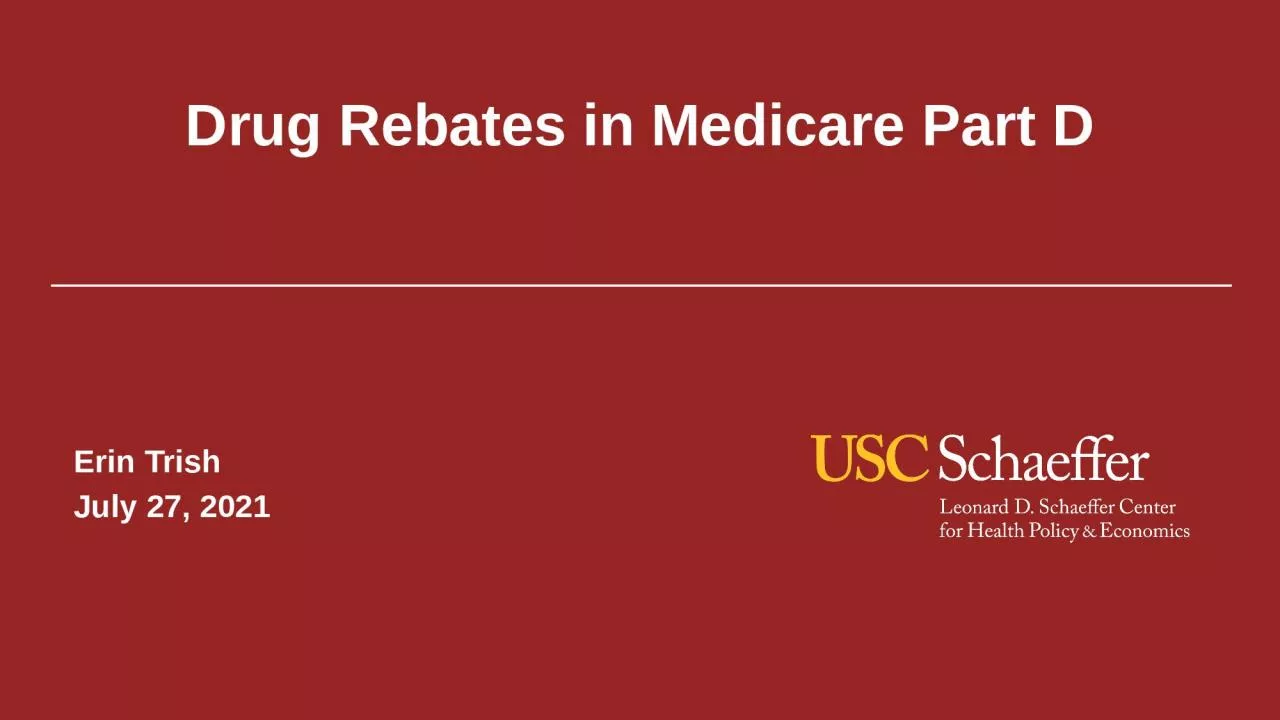

Erin Trish July 27 2021 Rebates create a wedge between list and net prices List price WAC Source Sood Ribero Ryan Van Nuys 2020 Notes WAC is wholesale acquisition cost Drugs included in the sample represent 380B in sales in 2016 84 of US branded prescription drug sales ID: 915096
Download Presentation The PPT/PDF document "Drug Rebates in Medicare Part D" is the property of its rightful owner. Permission is granted to download and print the materials on this web site for personal, non-commercial use only, and to display it on your personal computer provided you do not modify the materials and that you retain all copyright notices contained in the materials. By downloading content from our website, you accept the terms of this agreement.
Slide1
Drug Rebates in Medicare Part D
Erin Trish
July 27, 2021
Slide2Rebates create a wedge between list and net pricesList price (WAC)
Source:
Sood, Ribero, Ryan, Van Nuys (2020).
Notes:
WAC is wholesale acquisition cost. Drugs included in the sample represent ~$380B in sales in 2016 (~84% of US branded prescription drug sales). Rebates includes rebates and all other concessions, including Medicaid rebates. Dollars are not adjusted for inflation. .
Rebates
Net price
Slide3Part D benefit design encourages higher list prices by putting the government at greatest risk for high spending
Notes:
Benefit design is for non-LIS beneficiaries in 2021. The total drug costs for the catastrophic limit is estimated for an average non-LIS beneficiary. True out-of-pocket spending includes manufacturer-paid discounts.
$445 Total Drug Cost
$4,130 Total Drug Costs
Plan pays 75%
Enrollee pays 100%
$6,550 True Out-of-Pocket Spending
(approx. $10,048 Total Drug Costs)
CATASTROPHIC COVERAGE
Plan
15%
Government
80%
5%
Plan
5%
Manufacturer
70%
Enrollee
25%
Brand
Enrollee
25%
INITIAL
COVERAGE
PERIOD
Plan
75%
DEDUCTIBLE
Enrollee
100%
Enrollee
25%
COVERAGE
GAP
Plan
75%
Generic
Slide4Part D spending has become increasingly concentrated in catastrophic phaseCatastrophic spending
Note: About
8%
of beneficiaries reach catastrophic phase each year.
Source: Analysis using 100% Sample of Medicare Part D Event Files (2007-2016).
Reinsurance costs
Slide5Reinsurance Subsidy
Plan Bid
Beneficiary Premium
Premium
SubsidyDespite the growth in reinsurance subsidies, beneficiary premiums have been remarkably stable
Source:
Analysis using CMS Annual Releases of Part D National Average Bid Amount and Other Part C & D Bid Information. Premium subsidy is the direct subsidy.
Slide6Intermediate Projections
Source:
2020 Medicare Trustees Report. Table IV.B8.
Rebates have grown considerably, keeping premiums low
Slide7Source:
Lakdawalla and Li
(2021).
Notes: Benefit design is for non-LIS beneficiaries. The total drug costs (TDC) for the catastrophic limit is estimated for an average non-LIS beneficiary. True out-of-pocket (TrOOP) spending includes manufacturer-paid discounts.
$4
05
TDC
$
3,750
TDC
Plan pays 75%
Enrollee pays 100%
$
5,000
TrOOP
(~$
8,418 TDC)
CATASTROPHIC COVERAGE
Plan
15%
Government
80%
5%
Plan
15%
Manufacturer 50
%
Enrollee3
5%Enrollee25%
INITIAL
COVERAGE
PERIOD
Plan75%
DEDUCTIBLE
Enrollee
100%
COVERAGE
GAP
(Brand)
2018 Standard Benefit Design
Effective Beneficiary Cost-Sharing as a Share of Net Price
13%
64%
90%
Part D cost-sharing is tied to list price, so rebate growth
dilutes the benefit and increases out-of-pocket spending
Excess OOP spending is greatest for the
most competitive
drug classes
Slide8Basing cost-sharing on net rather than list price would reduce out-of-pocket spending for about half of beneficiaries 31% of non-LIS beneficiaries who reached catastrophic coverage would not have done so under a net price policy
Source:
Trish, Kaiser,
Joyce
(2020). Notes: Restricted to non-LIS beneficiaries. Cost-sharing based on list versus net price compared under standard benefit design. Analysis assumes no behavioral changes.
Slide9SummaryRebates have grown considerably, moderating growth in net drug pricesPart D dynamics encourage growth in list prices and rebates Rebate growth dilutes the Part D benefit and increases out-of-pocket spendingParticularly for beneficiaries taking drugs in the most competitive classesBeneficiaries taking highly-rebated drugs subsidize premiums for allPolicy changes are needed to alleviate out-of-pocket spending burden
Slide10